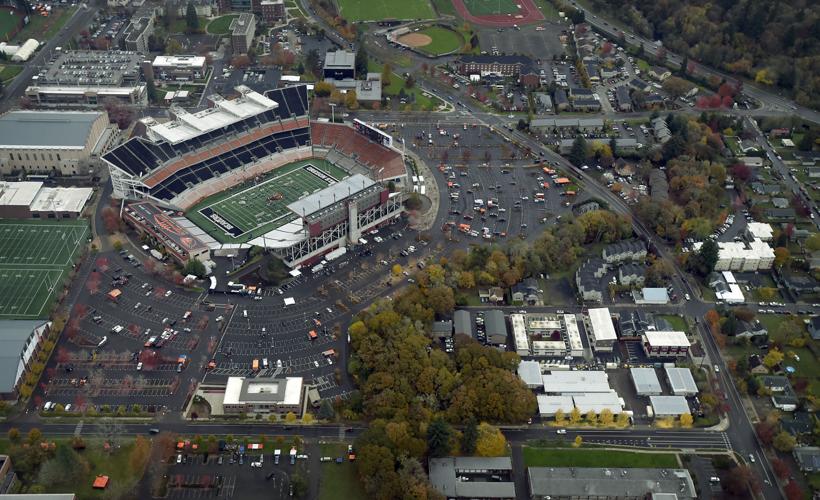A portion of Oregon State University’s Reser Stadium is set for demolition in January as part of its multimillion-dollar upgrade project.
The implosion of the west side is scheduled for Jan. 7, according to a university news release issued Thursday. The “Completing Reser Stadium” project will conclude a long-term Reser expansion/remodeling that began in 2005, while also adding a welcome center and wellness facilities.
“The decision to implode the westside stadium is all about safety,” Steve Clark, OSU vice president for university relations and marketing, said in a statement.
Here’s how that will work: “As implosion occurs, a series of explosive-like popping sounds will take place over approximately two seconds. Following these popping sounds, the stadium structure will safely fall vertically to the parking lot level around the stadium,” Clark said in a news release.
This is different than the traditional demolition process, he said. The work will be done by a licensed contractor.
During December, construction crews will begin prepping the west side of the stadium for full demolition, including removal of some steel and concrete. Then, between 7 and 8 a.m. Jan. 7, explosive charges will be set to implode the stadium’s west side. Implosion activities will fully comply with city of Corvallis permits that demolition contractors have applied for, Clark said.
To ensure safety during the implosion, residential, commercial and campus structures within 500 feet of the stadium’s west side will be unoccupied during the event. Out of an abundance of caution, Clark said occupants of buildings within 1,000 feet of the stadium will be asked to remain indoors and away from exterior windows and patios.
Several nearby streets – Southwest 26th, Southwest 30th, Southwest Grove streets and Southwest Western Boulevard – will be closed to vehicle, pedestrian and bicycle traffic for about 10 minutes before and after implosion activities, according to the university.
Information regarding a livestream event of the implosion will be shared in the weeks ahead.
The stadium project is expected to be completed before the start of the 2023 football season. The project includes construction of the new west side of the stadium, the welcome center for prospective new students and their families, and a wellness clinic that will serve students, OSU employees and community members.
Reser rendering
The stadium project is being funded through philanthropy led by the OSU Foundation, including a $50 million gift from an anonymous donor, premium seating and game day revenues. The welcome center will be funded by revenues from enrollment growth and the wellness center by various revenue sources.
The university has been working to modernize and improve the football stadium since 2005, when the east side was completely redone. The south end zone was upgraded between the 2006 and 2007 seasons, and the north end zone/Valley Football Center/locker room complex was redone in 2016.
The “Completing Reser Stadium” project involves replacing the west side grandstand and press box as well as adding the wellness center and welcome center to ensure use of the facility — and revenue generation — beyond certain Saturdays in the fall.
The initial construction cost is estimate at $153 million and will be paid for by $85 million in gifts, $40 million in state bonds and $28 million in OSU revenue bonds. However, a Corvallis Gazette-Times report in May showed that over a 50-year span, the stadium project will cost approximately $325 million.
The other $170 or so million include renewal costs of $50 million and interest payments and operational costs of $60 million apiece.
Construction will continue until the summer of 2023, with the stadium existing without a west side for the 2022 home season. Clark estimates that capacity for that season will be in the 27,000 range.
No official number has been established for the new capacity of the stadium. At its peak from 2007 to 2015 the stadium had an official capacity of 45,674. The Reser attendance record is 47,249 for a 2012 game against Oregon.
Capacity dropped to 43,000 after the north end zone work, and the remodeling project will end with capacity at approximately 35,000 to 39,000.
Article was originally published by Corvallis Gazette-Times.

